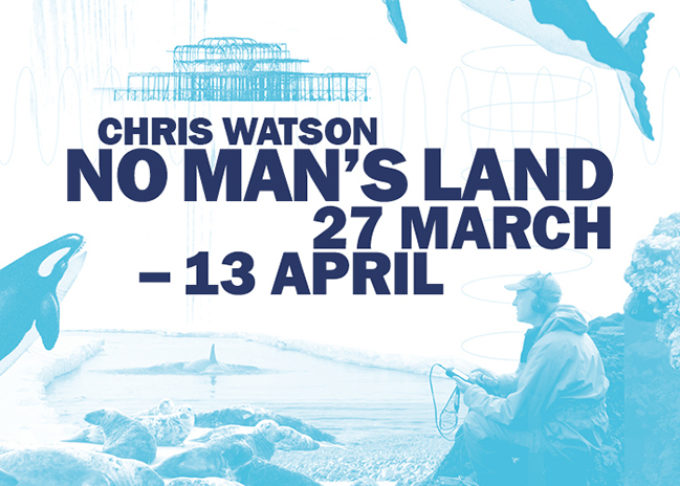


Continuing from our interviews with various members of Attenborough Centre for the Creative Arts team, we speak to Mark Murphy, an internationally acclaimed collage artist. Mark is also our graphic designer who works with our team to realise our brand and art direction in our print materials you see around the city and beyond.
We spent some time talking to Mark about the work he has created for Chris Watson’s No Man’s Land, as well as own practice.
You recently designed the Chris Watson material, what were your main inspirations for creating that piece?
In summer of 2017 I experienced Chris’s sound installation in a quarry in Torbay, as part of The Tale by Situations and Philip Hoare. It was amazing to hear sounds of the deep resonating around a huge quarry by the sea. It was massive juxtaposition, taking sounds that weren’t from that space and putting them into a vastly different context. My visual collage approach often explores juxtaposition too… I’ve worked as a designer for Attenborough Centre for the Creative Arts since 2015. In conversations with the team about the material for No Man’s Land, we decided upon a different approach from previous materials and something special that would stand out for this particular project in a new and different way. The collage of visual references worked well to convey the audio collage of Chris’s piece. The limited colours helped to unify the various elements, allowing a range of images to combine without everything feeling too busy.
Seeing a lot of your collage work we see many faceless subjects, are there any reasons or inspirations for this?
Many collage artists leave out, obstruct or replace faces. I think that a faceless figure, has the power to no longer represent the person in the original image, it becomes more about people generally than a person specifically. When I have exhibited original works, these pieces are well received. Viewers can more easily relate to an idea or composition and relate it to themselves when not looking at someone else’s face I think.
You say humour is a big part of your work, why is that? Do you think humour in collages (or art more broadly) is important?
I don’t think it’s essential by any means. I can think of many many powerful works that are completely unhumorous. That said, I do enjoy humorous art, but that can also depend on the humour… For me though, after lots of years of screen-based work, it’s been quite a joyful process connecting with a way of image making that is non digital again. It has limitations which is a challenge, but one I enjoy navigating. Perhaps, sometimes the enjoyment of the process shows itself in me making humorous work. Playing with scale can often have funny results, juxtaposing giant figures into vast landscapes will very often have a sense of humour.
What is your process when creating these collages, do you sketch them beforehand or leave it to the moment and experiment?
On occasion I have sketched an idea and worked from that, but mostly I experiment and make in the moment. I’m constantly collecting source materials. I particularly love older print (1950’s - 1970’s), the colour reproduction is often heavily saturated, which looks amazing.
The whole collage process I find quite mindful, from the quiet concentration of cutting out elements, to the experimentation on page. When I began making collages regularly about five years ago, I rarely stuck pieces down, I would try a myriad of compositions, photographing as I went - temporary collages - ephemeral…The more work I’ve made the more instinctual the process has become, I often just get a sense when a piece is ‘right’, and there is always an element of chance… what elements will present themselves from the piles of old books and magazines I’ve amassed.
How did you decide on the cut-out images you used for Chris Watson’s show?
The images chosen for Chris’s show were a combination of Chris’s photos, my own photographs and some vintage illustrations from a very old Norwegian nature book I picked up in a second-hand bookstore in Tromso, Norway, earlier this year.
The decisions were based largely around the sounds that feature in No Man’s Land, the cast list!
For more information on Chris Watson’s installation No Man’s Land check out our website here.